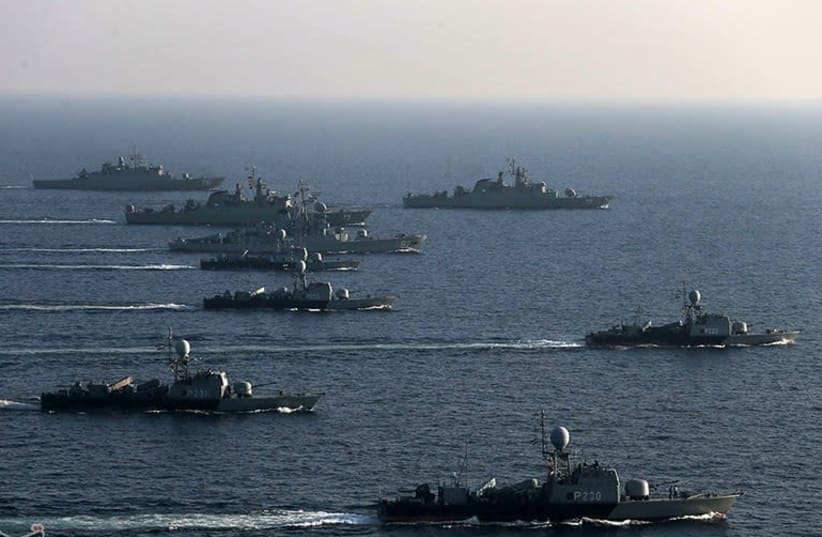The Bell 412 helicopter appears to be one of those old American helicopters that Iran has because it once had a bell helicopter Textron factory under the Shah. The 3rd Khordad system is more recent. It was used to down a $200 million American Global Hawk drone in June 2019. The six Ababil drones, noted in the photo, are part of Iran’s expanding drone arsenal. Iran used drones and cruise missiles to attack Saudi Arabia in September 2019. Iran has also sent drones to Syria and used them to threaten Israel and provided them to Hezbollah.According to H.I Sutton, who wrote the USNI news piece, the ship has four Qader anti-ship missiles, the Iranian version of the Chinese C-802. The ship is 492 feet long and 72 feet wide. It also has a 23 mm anti-aircraft guns. “It seems unlikely that these systems would be arrayed like this in normal operations. The small boats may be a common feature, but the other systems appear only representative of her potential capability and role,” Sutton writes. The assessment is that this ship is capable of long range missions and support.Iran has a relatively weak navy. It relies on the IRGC fast boats to harass US ships. The US warned the fast boats to stop harassing American ships in the spring and US President Donald Trump threatened to sink the Iranian ships. Iran has been training recently against a mock US aircraft carrier, a giant model it keeps sinking and strafing to show off. But Iran’s navy is no match for the American Fifth Fleet. The US Navy’s Nimitz Carrier Strike Group recently left the Persian Gulf to train with Japan, India and Australia for a drill called Malabar. The US is increasingly working with India on regional security. India is also a close partner of Israel and the UAE. US carriers can be at sea for a very long time. The Abraham Lincoln was at sea for 295 days, during which it also went to the US 5th Fleet base in Bahrain. US ships such as the guided-missile cruiser USS Philippine Sea and USNS Wally Schirra and USS Winston Churchill are in the area as well. Even though the US Navy has immense firepower, the new Iranian ship is still an asymmetric threat. Sutton writes in a separate post at Covert Shores “in fact while the IRGC-N has been limited to local operations in the Persian Gulf, the IRGC as a whole is active further afield. They have interests in Syria for example. So she may turn up in the Mediterranean to support IRGC efforts ashore. Or provide intelligence to proxy forces in conflicts which Iran is technically not involved in.” This might involve supporting the Houthis in Yemen, for instance.Other experts, such as Jeremy Binnie of Janes Defense Weekly, noted that the new Iranian ship is likely a ship built in Italy in 1992 once called Galaxy F. He pointed out online that it carries a 2031 Radar unit that is used to “support long-range anti-ship missiles.” Could this be a forward base for the IRGC, or part of an expeditionary unit? It was provided to the IRGC likely to harass Iran’s foes. That could be Gulf states or Israel or the US. Iran has provided the Houthis with drones and ballistic missiles to attack Riyadh in recent years. The US Navy helped intercept three of these shipments over the years. The US also maintains what is called by those in the know, the “petting zoo” in Washington where captured Iranian missiles and drones provided to the Houthis are shown to experts.Furthermore, Iran has been building new drones. It has showcased drones armed with missiles in September and it has shown off a new train capable of carrying ballistic missiles on November 5. An arms embargo on Iran ended last month and Iran says it may soon be exporting weapons.Also Iran recently began working with North Korea again on missile development, US reports indicated in October. Iran has also shown off a new Pars satellite it wants to launch. Tal Inbar, an expert on aerospace technology, has tweeted images noting Iran’s Sejil missile put on a launcher and also reports about the deputy head of Iran’s Space Research Center Jafar Salehi announcing plans for a new launch of a 100kg satellite. The satellite may be for telecommunications. Iran launched its first military satellite in April.Video of the ship was put online on November 19. Clearly Iran is sending yet another message to the region that it has the indigenous technology to build numerous weapons. Reports that this was an “aircraft carrier” style of ship were a bit exaggerated, but this new Iranian ship certainly gives the country more options at sea.Iran has done joint training with Russia and Iran at sea, a message to the West and Gulf that it has allies in far away places. Israel struck Iranian IRGC Quds Force sites in Syria on November 18. Israel said it was sending a message to Iran and Prime Minister Benjamin Netanyahu warned Iran against entrenching in Syria. Iran is now entrenching at sea it seems.Iran's Shaid Rudaki of the IRGc naval forces pic.twitter.com/BdWSRzSMen
— Tal Inbar (@inbarspace) November 19, 2020
Iran has a new warship packed with drones and missiles
On its surface this is just a transport ship, but Iran has crowded its deck with all sorts of weapons to show off what it can do.
